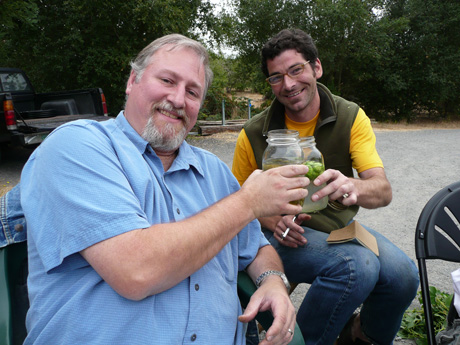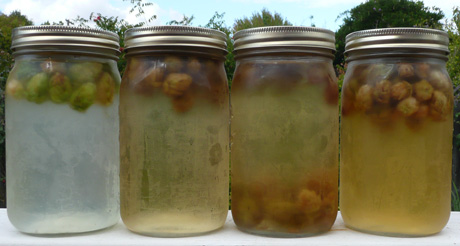
A few weeks ago while helping Moonlight with their hop harvest, owner/brewer Brian Hunt broke out something I’d never seen before: hop tea. Now I’ve seen regular hop tea before, I’ve even bought some at the health food store and tried it, but this was something totally different. Brian told me the idea grew out of an experiment he was doing to see how hops reacted at different temperatures, which he presented at “Hop School” a few years ago. He discovered in the process that he could make a delicious hop tea and that it varied widely depending on the temperature of the water. Here’s how it works:
- Put approximately two-dozen fresh hop cones in a 16 oz. mason jar.
- Heat water to __X__ temperature.
- Fill jar with heated water and seal cap.
- Let the water come down to ambient room temperature.
- Refrigerate.
- Drink.
There appears to be four main factors that change depending on the temperature of the water. These are:
- Color
- Float
- Bitterness
- Tannins

Intrigued by all of this and quite curious, Brian brought out seven examples of his hop tea made with water of different temperatures: 60°, 120°, 130°, 140°, 160°, 180° and 185°. They’re shown above from lower to higher temperature, left to right.
As you can see, the lower the temperature, the more green the hops are and the water remains less cloudy. At the higher temperatures, the hops are stripped of their green, becoming brown, and the water also becomes more brown. Also, as the temperature increases, the hops lose their buoyancy and begin to sink in the water. Although you can’t see it in the photo, the hotter the water, the more hop bitterness and at the upper range, tannins begin to emerge. Here’s what I found:
- 60°: Fresh, herbal aromas with some hop flavors, but it’s light.
- 120°: Bigger aromas, less green more vegetal flavors.
- 130°: Also big aromas emerging, flavors beginning to become stronger, too, but still refreshingly light.
- 140°: More pickled, vinegary aroma, no longer subtle with biting hop character and strong flavors.
- 160°: Very big hop aromas with strong hop flavors, too, with a touch of sweetness. Tannins are becoming evident but are still restrained.
- 180°: Big hop and vinegary aromas, with flavors becoming too astringent and tannins becoming overpowering.
- 185°: Vinegary aromas, way too bitter and tannins still overpowering.

Trying each of the tea samples with Tim Clifford, who writes for Northwest Brewing News.

Brian was kind enough to let me take a small bag of fresh hops with me so I could recreate his experiment at home. I had enough for four samples and made tea at 100°, 140° and 160°. Using two dozen hop cones made the jars look light so I used three-dozen in the last jar, also using 160° water. I tasted them with my wife, hoping to get a civilian opinion, too. Here’s what we found:
- 100°: Hops still green and floating. The nose was very vegetal and reminded my wife of the water leftover in the pot after you’ve steamed vegetables like broccoli or Brussels sprouts. The mouthfeel is somewhat gritty with light, refreshing flavors and only a little bitterness, which dissipates quickly.
- 140°: Hops turned brown, but still floating. Light hop aromas with some smokey, roasted aromas and even a hint of caramel. Fresh hop flavors with a clean finish. My wife, however, made that puckering bitter face signaling she found it repugnant.
- 160°: Hops turned brown, but most has sunk to the bottom of the jar. Strong hop aromas and few negatives, at least from my point of view. My wife was still making that face, cursing me for dragging her into this. Hop bitterness had become more pronounced and tannins were now evident, with a lingering finish.
- 160° Plus: This sample had 50% more hops. The hops had also turned brown but, curiously, they were still floating. The nose was vegetal with string hop aromas. With a gritty mouthfeel, the flavors were even more bitter covering the tannins just slightly, but they were still apparent, and the finish lingered bitterly.
It seems like either 140° or 160° is the right temperature. Lower than that and you don’t get enough hop character (I’m sure that’s why the hops remain green) but above that the tannins become too pronounced. It appears you have to already like big hop flavor or you’ll hate hop tea. I found it pretty enjoyable and even refreshing though it’s still probably best in small amounts. You do seem to catch a little buzz off of it, which doesn’t hurt. I’m sure the amount of hops is important and more research may be needed on that front. Brian tells me that hop pellets can also be used though I doubt the jar of tea looks as attractive using them. They have the advantage of being available year-round, of course. If you use pellets, you need only about a half-ounce for each pint jar.
If you try to make Hunt’s Hop Tea on your own, please let me know your results. And please do raise a toast to Brian Hunt’s ingenuity.

“OG: 1.000 – FG: 1.000”
*That* is truly extreme beer. Thanks, Jay
A similar phenomenon occurs when drinking whole green tea re: the sinking effect. Hotter water causes the tea leaves to sink to the bottom of the glass quicker.
The 160+ probably had less sinking because the extra hops became more of a heat sink, and the temperature after infusion would have been a little lower.
Quart jars are my preference, but any jar will work.
Jay – great post, really informative. Have you heard of anyone adding hop tea to a beer as an alternative to dry-hopping? It sounds like it could be worth trying.
I was thinking of putting pellets in a coffee filter and making a pot of hop tea any thoughts on this???
I am sorry but the hop teas in the mason jars look really gross. Yuck! But I must try this anyway.
I just harvested some of my mature ‘cascade’ hops and decided to make them into a tea, which turned out excellent. I then decided to do a search, and found this website.
I don’t think one must follow such strict guidelines, although it’s good to know that 160 is the preferred temperature. I only used four good sized mature hops, which I cut in half with a pair of kitchen scissors. I then proceeded to put them directly into a glass mug that I use for tea (which I am an avid connoisseur.)
I added water that was just below a full boil, and let it steep for about three minutes, stirring occasionally. The hops took a minute or so to start to fully saturate and fall. It was beautiful to watch them expand, even though they were fresh. I then poured it through a micro-filter for tea into another glass, which had ice in it.
The brew looked very nice, a very pale light lime green. Upon looking closely before stirring, you can see all of the particles swirling around beautifully. The lupin glands (or pollen?) seemed to weight the most, as it all settled to the bottom of the glass. It smelled very vegetal, almost grass-like, and quite mildly of hops.
Upon stirring and tasting, I was surprised that I actually enjoyed it. It took a few sips to get used to, but it grew on me. It tasted more like beer than it smelled, which I expected. The bitterness was most certainly there, but was not overwhelming. It was on the scale of an average I.P.A. in the international bitterness unit scale.
I think I will add a bit of honey next time, as it lacked any real body.
I am quite sensitive to bio-chemically induced physical or mental effects, and I most certainly noticed a mild buzz. It was similar to when drinking, but with a pleasant clarity that I never experienced, probably due to the alcohol usually present.
I did some research, and found out that hops used to be called “The ‘Good Night’ Flowers.” It has a lot of vitamins and minerals, as well as effects such as antiseptic, antibiotic, antispasmodic, antimicrobial, anti-anxiety, and as a digestive aid. For females, apparently it is very effective for PMS and it’s symptoms. Some find it effective in IBS, nervous system problems, hysteria, diverticulitis, mucous colitis, digestive problems, insomnia and tension. Due to it’s asparagin content, it can been used to reduce fluid tension. It’s steam as an inhalant helps sore throats and chest conditions. They make pillows filled with hops for insomnia. It reduces fevers, kills worms, and can even be used as a mild pain killer. It stimulates the liver, and when used topically can help give one healthy, clear skin. Wow!
So, just thought I would throw out my experience and some knowledge. Crack a cold one for me!
-Ryan (Chicago, IL)
De-alcoholized beer sucks, but I discovered I can make it interesting by adding a strong hop infusion (tea) that I make in advance and keep in the fridge for the purpose.
Made an experimental 1/2 gal. batch of fresh hopped green sun tea today. It is pretty dang good if you are a fan of hops. I picked 10 fresh hop bines from my two year old Centennial hop vines, put them in 1/2 gal. mason jar with straight tap water and 4 bags of green tea. Through on the top and sat it in the afternoon sun on my back deck for two hours. Strained off the hops and tea bags and into the fridge. The tea has a great hop aroma and a slight but noticeable hop flavor. In the future I will add more hop bines and leave to steep a little longer for a stronger hop flavor, but for an experiment I think it worked out great!